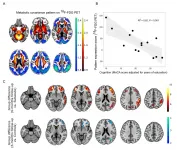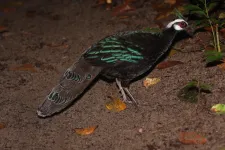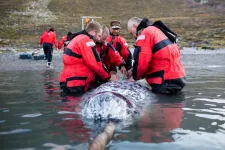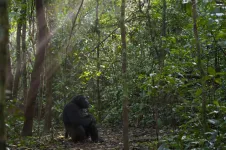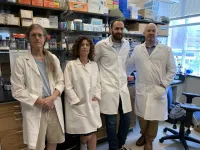(Press-News.org) Reston, VA--The effects of COVID-19 on the brain can be accurately measured with positron emission tomography (PET), according to research presented at the Society of Nuclear Medicine and Molecular Imaging (SNMMI) 2021 Annual Meeting. In the study, newly diagnosed COVID-19 patients, who required inpatient treatment and underwent PET brain scans, were found to have deficits in neuronal function and accompanying cognitive impairment, and in some, this impairment continued six months after their diagnosis. The detailed depiction of areas of cognitive impairment, neurological symptoms and comparison of impairment over a six-month time frame has been selected as SNMMI's 2021 Image of the Year.
Each year, SNMMI chooses an image that best exemplifies the most promising advances in the field of nuclear medicine and molecular imaging. The state-of-the-art technologies captured in these images demonstrate the capacity to improve patient care by detecting disease, aiding diagnosis, improving clinical confidence, and providing a means of selecting appropriate treatments. This year, the SNMMI Henry N. Wagner, Jr., Image of the Year was chosen from more than 1,280 abstracts submitted to the meeting and voted on by reviewers and the society leadership.
"As the SARS-CoV-2 pandemic proceeds, it has become increasingly clear that neurocognitive long-term consequences occur not only in severe COVID-19 cases, but in mild and moderate cases as well. Neurocognitive deficits like impaired memory, disturbed concentration and cognitive problems may persist well beyond the acute phase of the disease," said Ganna Blazhenets, PhD, a post-doctoral researcher in Medical Imaging at the University Medical Center Freiburg, in Freiburg, Germany.
To study cognitive impairment associated with COVID-19, researchers carried out a prospective study on recently diagnosed COVID-19 patients who required inpatient treatment for non-neurological complaints. A cognitive assessment was performed, followed by imaging with 18F-FDG PET if at least two new neurological symptoms were present. By comparing COVID-19 patients to controls, the Freiburg group established a COVID-19-related covariance pattern of brain metabolism with most prominent decreases in cortical regions. Across patients, the expression of this pattern showed a very high correlation with the patients' cognitive performance.
Follow-up PET imaging was performed six months after the initial COVID-19 diagnosis. Imaging results showed a significant improvement in the neurocognitive deficits in most patients, accompanied by an almost complete normalization of the brain metabolism.
"We can clearly state that a significant recovery of regional neuronal function and cognition occurs for most COVID-19 patients based on the results of this study. However, it is important to recognize the evidence of longer-lasting deficits in neuronal function and accompanying cognitive deficits is still measurable in some patients six months after manifestation of disease," noted Blazhenets. "As a result, post-COVID-19 patients with persistent cognitive complaints should be presented to a neurologist and possibly allocated to cognitive rehabilitation programs."
"18F-FDG PET is an established biomarker of neuronal function and neuronal injury," stated SNMMI's Scientific Program Committee chair, Umar Mahmood, MD, PhD. "As shown the Image of the Year, it can be applied to unravel neuronal correlates of the cognitive decline in patients after COVID-19. Since 18F-FDG PET is widely available, it may therefore aid in the diagnostic work-up and follow-up in patients with persistent cognitive impairment after COVID-19."
INFORMATION:
Abstract 41. "Altered regional cerebral function and its association with cognitive impairment in COVID 19: A prospective FDG PET study." Ganna Blazhenets, Johannes Thurow, Lars Frings and Philipp Meyer, Department of Nuclear Medicine, Medical Center - University of Freiburg, Faculty of Medicine, University of Freiburg, Freiburg, Germany; Nils Schroeter, Tobias Bormann, Cornelius Weiller, Andrea Dressing and Jonas Hosp; Department of Neurology and Clinical Neuroscience, Medical Center - University of Freiburg, Faculty of Medicine, University of Freiburg, Freiburg, Germany; and Dirk Wagner, Department of Internal Medicine, Medical Center - University of Freiburg, Faculty of Medicine, University of Freiburg, Freiburg, Germany.
All 2021 SNMMI Annual Meeting abstracts can be found online at https://jnm.snmjournals.org/content/62/supplement_1.
About the Society of Nuclear Medicine and Molecular Imaging
The Society of Nuclear Medicine and Molecular Imaging (SNMMI) is an international scientific and medical organization dedicated to advancing nuclear medicine and molecular imaging, vital elements of precision medicine that allow diagnosis and treatment to be tailored to individual patients in order to achieve the best possible outcomes.
SNMMI's members set the standard for molecular imaging and nuclear medicine practice by creating guidelines, sharing information through journals and meetings and leading advocacy on key issues that affect molecular imaging and therapy research and practice. For more information, visit http://www.snmmi.org.
LMU researchers have identified the 14-3-3sigma gene as an important suppressor of carcinogenesis in the gastrointestinal tract.
Intestinal cancers, also known as colorectal cancer, are among the most prevalent forms of malignancy worldwide. If detected early enough, tumors can be surgically excised. However, as cancer growth progresses, cells may escape from the primary tumor, which can then establish metastatic tumors in other organs. Once such satellite tumors have formed, survival rates fall significantly. Formation of the initial tumor can be triggered by mutations in any of a number of genes. Together with postdocs ...
CHAMPAIGN, Ill. -- Health care workers often don't adopt new guidelines for best practices in medical care until well after those guidelines are established. A team of researchers led by Eunice E. Santos, the dean of the School of Information Sciences at the University of Illinois Urbana-Champaign, has developed a new computational modeling and simulation framework to analyze decision-making and identify effective dissemination strategies for medical guidelines.
The research team examined guidelines for Type 2 diabetes that were established in 2012 and were still not adopted years later. The researchers found that health ...
The lush forests and more than 7,000 islands of the Philippines hold a rich diversity of life, with 258 bird species who live nowhere but the Philippine archipelago. A new study from University of Utah researchers suggests that, due to deforestation and habitat degradation, more bird species may be endangered that previously thought - including species that may not have been discovered yet. The study is published in Frontiers in Ecology and Evolution.
"Our study provides a roadmap for not only which species may warrant heightened conservation attention," says Kyle Kittelberger, a doctoral student in the University of Utah School of Biological Sciences, "but which traits ...
An algorithm can predict when narwhals hunt - a task once nearly impossible to gain insight into. Mathematicians and computer scientists at the University of Copenhagen, together with marine biologists in Greenland, have made progress in gathering knowledge about this enigmatic Arctic whale at a time when climate change is pressuring them.
The small whale, known for its distinctively spiraled tusk, is under mounting pressure due to warming waters and the subsequent increase in Arctic shipping traffic. To better care for narwhals, we need to learn more about their foraging behaviour - and how these may change as a result of human disturbances and global warming. Biologists know almost nothing about this. Because narwhals live in isolated Arctic regions and ...
For many of us, our smartphone has become our ever-present companion and is usually far more than just a phone. Thanks to the constant availability of online content as well as our reachability through messenger services and social networks via our smartphone, this everyday object's potential to distract us is high - at work too. This is why many employers view the use of smartphones during work time with suspicion, and countermeasures taken range from asking staff to refrain voluntarily from using them to banning smartphones in the workplace through an internal agreement. But do such measures actually work and, if so, how?
This is the ...
DURHAM, N.C. - Special diets, exercise programs, supplements and vitamins -- everywhere we look there is something supposed to help us live longer. Maybe those work: human average life expectancy has gone from a meager 40-ish years to a whopping 70-something since 1850. Does this mean we are slowing down death?
A new study comparing data from nine human populations and 30 populations of non-human primates says that we are probably not cheating the reaper. The researchers say the increase in human life expectancy is more likely the statistical outcome of improved survival for children and young adults, not slowing the aging clock.
"Populations get older mostly because more individuals get through those early stages of life," ...
In the majority of insects, metamorphosis fosters completely different looking larval and adult stages. For example, adult butterflies are completely different from their larval counterparts, termed caterpillars. This "decoupling" of life stages is thought to allow for adaptation to different environments. Researchers of the University of Bonn now falsified this text book knowledge of evolutionary theory for stoneflies. They found that the ecology of the larvae largely determines the morphology of the adults by investigating 219 earwig and stonefly species at high-resolution particle accelerators. The study has ...
Osteoporosis researchers at the UVA School of Medicine have taken a new approach to understanding how our genes determine the strength of our bones, allowing them to identify several genes not previously known to influence bone density and, ultimately, our risk of fracture.
The work offers important insights into osteoporosis, a condition that affects 10 million Americans, and it provides scientists potential new targets in their battle against the brittle-bone disease.
Importantly, the approach uses a newly created population of laboratory mice that allows researchers to identify relevant genes and overcome limitations of human studies. Identifying such genes has been very difficult but is key to using genetic discoveries to improve ...
Woods Hole, MA (June 16, 2021) -- Woods Hole Oceanographic Institution (WHOI) climate modeler Dr. Alan Condron and United States Geological Survey (USGS) research geologist Dr. Jenna Hill have found evidence that massive icebergs from roughly 31,000 years ago drifted more than 5000km (> 3,000 miles) along the eastern United States coast from Northeast Canada all the way to southern Florida. These findings were published today in Nature Communications.
Using high resolution seafloor mapping, radiocarbon dating and a new iceberg model, the team analyzed about 700 iceberg scours ("plow marks" on the seafloor left behind by the bottom parts of icebergs dragging through marine sediment ) from Cape Hatteras, North Carolina to the Florida Keys. ...
Researchers from the Max-Planck Institute for Terrestrial Microbiology have discovered a surprising asymmetry in the mating behavior of unicellular yeast that emerges solely from molecular differences in pheromone signaling. Their results, published in the current issue of "Science Advances", might shed new light on the evolutionary origins of sexual dimorphism in higher eukaryotes.
Resemblant of higher organisms, yeast gametes communicate during the mating process by secreting and sensing sexual pheromones. However, in contrast to higher eukaryotes, budding yeast is isogamous: seen through a microscope, gametes of both mating types ("sexes"), MATa and MATα, look exactly the same. Since anisogamy -- difference in size between male and female gametes --was ...
